
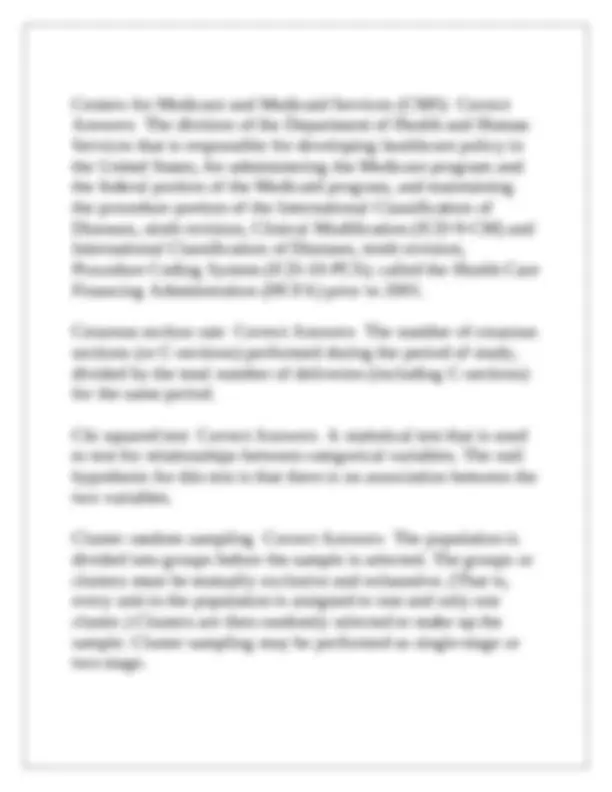

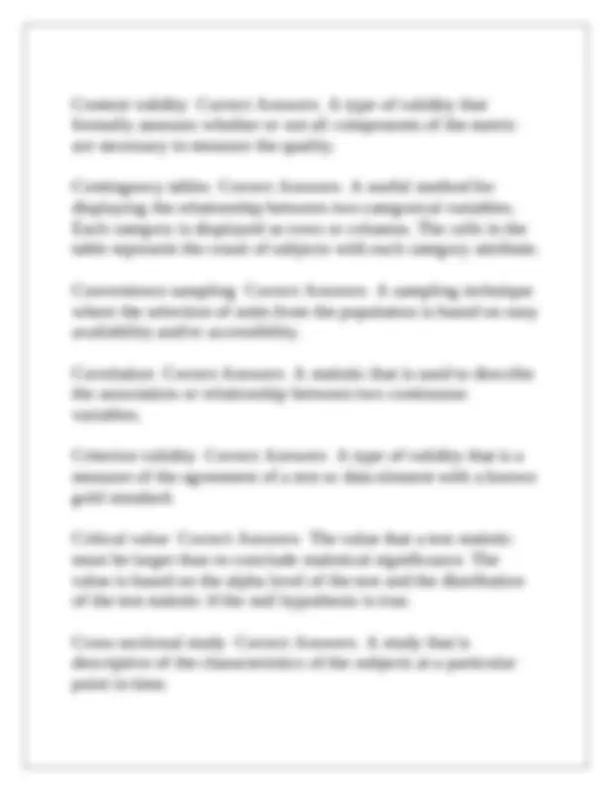


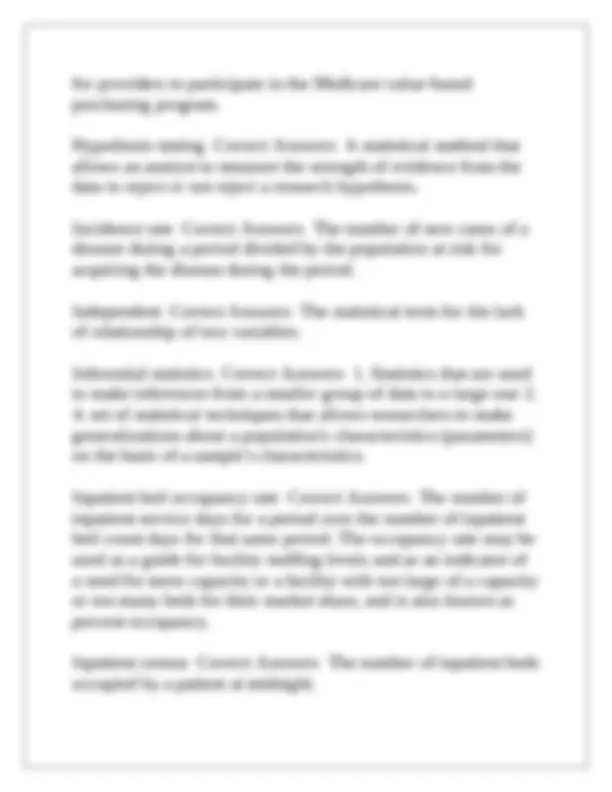



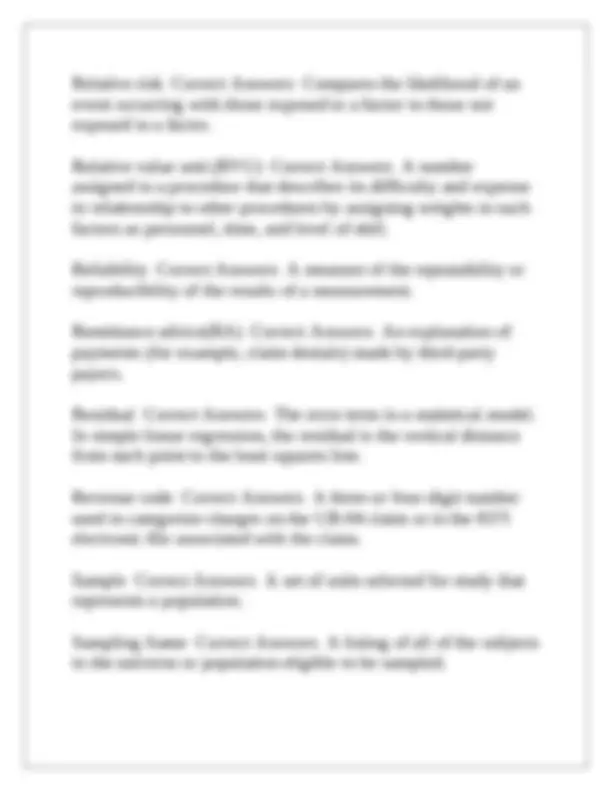

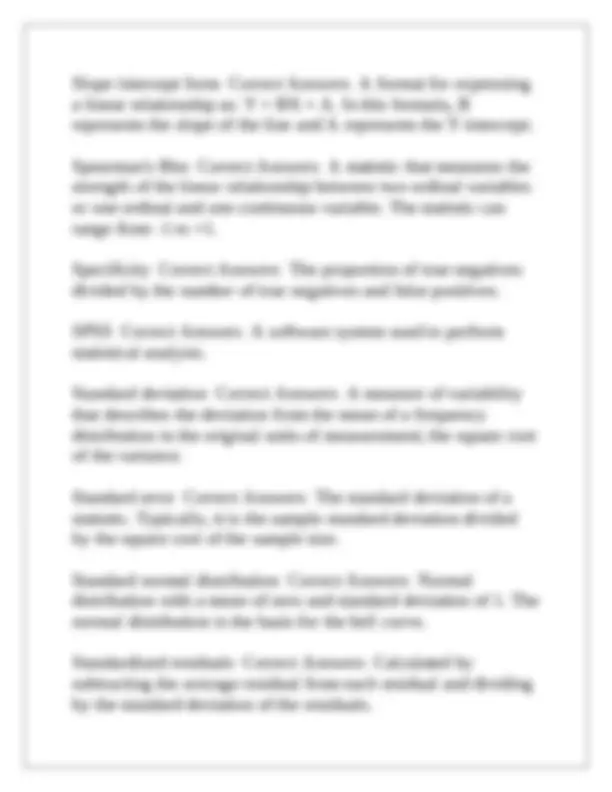


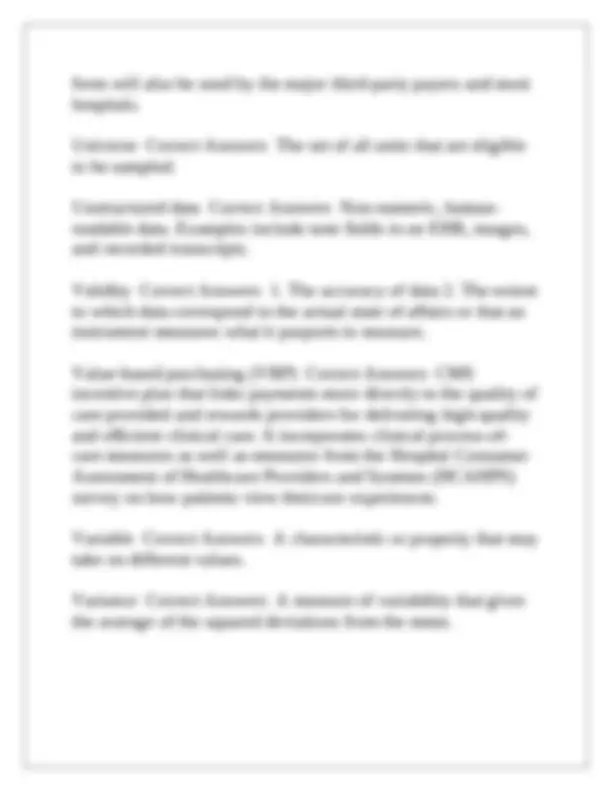


Study with the several resources on Docsity

Earn points by helping other students or get them with a premium plan


Prepare for your exams
Study with the several resources on Docsity

Earn points to download
Earn points by helping other students or get them with a premium plan
Community
Ask the community for help and clear up your study doubts
Discover the best universities in your country according to Docsity users
Free resources
Download our free guides on studying techniques, anxiety management strategies, and thesis advice from Docsity tutors
A comprehensive glossary of terms related to healthcare data analysis (chda), covering concepts from statistical hypothesis testing to healthcare payment systems. It defines key terms like alpha level, alternative hypothesis, ambulatory payment classification (apc), and case mix index (cmi), offering concise explanations for each. Valuable for students and professionals seeking to understand the fundamental concepts and terminology used in healthcare data analysis.
Typology: Exams
1 / 23

This page cannot be seen from the preview
Don't miss anything!
















CHDA Test Review Book Terms Questions With Complete Solutions Alpha level Correct Answers The level of Type I error that is deemed acceptable based on context in statistical hypothesis testing. See Type I error. Alternative hypothesis Correct Answers The complement of the null hypothesis that is to be tested using the appropriate statistical test. This hypothesis typically requires some action to be taken. Ambulatory payment classification (APC) Correct Answers The payment unit used in the hospital outpatient prospective payment system (OPPS). The classification is a resource-based reimbursement system. Analysis Correct Answers Reviewing and summarizing data for use in decision making. Analysis of variance Correct Answers The statistical tool used to compare more than two population means. The null hypothesis tests that all of the population means are equal. Analytic study Correct Answers A study where the analyst is able to investigate the relationship between variables. Auditing Correct Answers The performance of internal and external reviews to identify variations from established baselines (for example, review of outpatient coding as compared with CMS outpatient coding guidelines).
Average daily inpatient census Correct Answers An amount representing the inpatient service days for a period divided by the number of days in a period. Balanced design Correct Answers An experimental design where the number of subjects in each sample are the same for all populations sampled. The term is relevant when performing an analysis of variance or a two sample t-test. Bell curve Correct Answers The shape of the normal distribution. The bell peaks at the average and slopes down on both sides symmetrically. Binomial variable Correct Answers A variable that takes only two values (such as yes or no; alive or dead). The probability of a yes or no is constant across all of the subjects, and the outcome of each subject is independent of the others. Case Mix Index (CMI) Correct Answers The average relative weight of all cases treated at a given facility or by a given physician, which reflects the resource intensity or clinical severity of a specific group in relation to the other groups in the classification system; calculated by dividing the sum of the weights of diagnosis-related groups for patients discharged during a given period by the total number of patients discharged.
Case-control study Correct Answers A study where the analyst- selected cases are those units of analysis with the attribute to be studied and the controls are those without the attribute.
CMS-1500 Correct Answers 1. The universal insurance claim form developed and approved by the American Medical Association (AMA) and the Centers for Medicare and Medicaid Services (CMS) that physicians use to bill Medicare, Medicaid, and private insurers for professional services provided 2. A Medicare claim form used to bill third-party payers for provider services, for example, physician office visits. Coefficient of determination Correct Answers A statistic that measures the amount of variance in a dependent variable explained by one or more independent variables. If there is one independent variable, then this value is the Pearson Correlation Coefficient squared. Cohort study Correct Answers A study where the subjects with an attribute are matched with those without the attribute based on demographics, but the subjects are followed over time. Confidence interval Correct Answers An interval that is centered at the sample estimate of a population value that may be calculated so that it has a preset probability of containing the population value. Confidence level Correct Answers The probability that a confidence interval includes the true value of a population statistic. Construct validity Correct Answers A type of validity that is typically measured for survey and assessment tools, using instruments designed to measure the constructs or concepts of satisfaction with a provider's performance.
Content validity Correct Answers A type of validity that formally assesses whether or not all components of the metric are necessary to measure the quality. Contingency tables Correct Answers A useful method for displaying the relationship between two categorical variables. Each category is displayed as rows or columns. The cells in the table represent the count of subjects with each category attribute. Convenience sampling Correct Answers A sampling technique where the selection of units from the population is based on easy availability and/or accessibility. Correlation Correct Answers A statistic that is used to describe the association or relationship between two continuous variables. Criterion validity Correct Answers A type of validity that is a measure of the agreement of a test or data element with a known gold standard. Critical value Correct Answers The value that a test statistic must be larger than to conclude statistical significance. The value is based on the alpha level of the test and the distribution of the test statistic if the null hypothesis is true. Cross-sectional study Correct Answers A study that is descriptive of the characteristics of the subjects at a particular point in time.
Descriptive statistics Correct Answers A set of statistical techniques used to describe data such as means, frequency distributions, and standard deviations; statistical information that describes the characteristics of a specific group or a population. Descriptive studies Correct Answers A study where data is collected to generate hypotheses for more formal analytic or experimental studies, since little is known about the variables to be studied. Diagnosis-related group (DRGs) Correct Answers A unit of case-mix classification adopted by the federal government and some other payers as a prospective payment mechanism for hospital inpatients in which diseases are placed into groups because related diseases and treatments tend to consume similar amounts of healthcare resources and incur similar amounts of cost; in the Medicare and Medicaid programs, one of more than 500 diagnostic classifications in which cases demonstrate similar resource consumption and length-of-stay patterns. Under the prospective payment system (PPS), hospitals are paid a set fee for treating patients in a single DRG category, regardless of the actual cost of care for the individual. Diagnostic data Correct Answers The data obtained when diagnoses or reasons for visit are coded with a diagnostic classification system. Distribution Correct Answers The pattern of values for a variable. The distribution may be characterized by center and spread or frequency of values.
Double-blind study Correct Answers A study where both the subject and the researcher administering the treatment are blinded to ensure that the researcher is not biased in the data collection process. Entity relationship diagram Correct Answers A specific type of data modeling used in conceptual data modeling and the logical- level modeling of relational databases. Experimental study Correct Answers A study that allows the determination of cause and effect between two variables. Exploratory data analysis Correct Answers The use of graphical techniques to identify and explore patterns in data. Face validity Correct Answers A type of validity that is not quantitatively measured, but includes an expert assessment to determine if the metric appears to measure the quantity it was intended to measure. Frequency chart Correct Answers A graphical representation of a frequency distribution. Typically displayed as a bar chart where the height of the bars represent the frequency of observations in each category. Also known as a histogram. Frequency distribution Correct Answers A table or graph that displays the number of times (frequency) a particular observation occurs.
for providers to participate in the Medicare value-based purchasing program. Hypothesis testing Correct Answers A statistical method that allows an analyst to measure the strength of evidence from the data to reject or not reject a research hypothesis. Incidence rate Correct Answers The number of new cases of a disease during a period divided by the population at risk for acquiring the disease during the period. Independent Correct Answers The statistical term for the lack of relationship of two variables. Inferential statistics Correct Answers 1. Statistics that are used to make inferences from a smaller group of data to a large one 2. A set of statistical techniques that allows researchers to make generalizations about a population's characteristics (parameters) on the basis of a sample's characteristics. Inpatient bed occupancy rate Correct Answers The number of inpatient service days for a period over the number of inpatient bed count days for that same period. The occupancy rate may be used as a guide for facility staffing levels and as an indicator of a need for more capacity or a facility with too large of a capacity or too many beds for their market share, and is also known as percent occupancy. Inpatient census Correct Answers The number of inpatient beds occupied by a patient at midnight.
Inpatient prospective payment system (IPPS) Correct Answers Payment system used by CMS to reimbursed providers for inpatient hospital services provided to Medicare beneficiaries. Inpatient service day Correct Answers The unit that measures the services delivered to one patient in a 24 hour period. Interval scale Correct Answers Numeric data where the distance between two values has meaning, but multiplying values has no meaning. Interval scale variables have no true zero value. Temperature measurement is an example of interval data. Judgment sampling Correct Answers A sampling technique where the researcher relies on his or her own judgment to select the subjects based on relevant expertise. Least squares regression line Correct Answers The line that minimizes the sum of the squared error values between the data points and the line. The line should be as close as possible to all points and not above or below all of them, so the value to be minimized is the squared error values to remove the positive or negative sign from the residual. Levene's test Correct Answers A hypothesis test used to test the hypothesis that two population variances are equal. Logical Observation Identifiers Names and Codes (LOINC) Correct Answers A database protocol developed by the Regenstrief Institute for Health Care, aimed at standardizing laboratory and clinical codes for use in clinical care, outcomes management and research.
Net autopsy rate Correct Answers The numerator of the net autopsy rate is the same as the gross autopsy rate, the number of autopsies performed in the period, but the denominator is the number of bodies available for autopsy. Net mortality rate Correct Answers Equal to the gross mortality rate ratio, but with any patients that died within 48 hours of admission to the hospital removed from both the numerator and denominator. Nominal scale Correct Answers Measurement scale that consists of categories with no natural or inferred order. Examples include: diagnosis codes, clinical units, and color. Non-probability sampling Correct Answers A sampling methodology where members of a sample are deliberately selected for a specified purpose. The sample is not selected at random and may not be used to make inference about the population. Null hypothesis Correct Answers In hypothesis testing, the null hypothesis is typically the status quo or neutral position. Odds ratio Correct Answers Measures the increased odds of a subject contracting a disease or condition when the risk factor is present. One sample z-test for proportions Correct Answers A hypothesis test for sample proportions that is used to test if the
sample data collected supports the null hypothesis that the population proportion is equal to a fixed or standard value. One-sample t-test Correct Answers A hypothesis test for the sample mean that is used to test if the sample data collected supports the null hypothesis that the population mean is equal to a fixed or standard value. Ordinal scale Correct Answers Measurement scale that consists of categories with a natural or inferred order. Examples include patient satisfaction scores, severity scores, and clinic visit level. Outpatient Prospective Payment System (OPPS) Correct Answers The Medicare prospective payment system used for hospital-based outpatient services and procedures that is predicated on the assignment of ambulatory payment classifications. P-value Correct Answers 1. The probability of incorrectly rejecting the null hypothesis given the sample data collected. 2. The smallest alpha level for which the null hypothesis would be rejected. Paired t-test Correct Answers A hypothesis test used to compare a variable measured at two time points on the same subject or comparing values between match pairs. The null hypothesis is that there is no difference between the two time point or pair means.
Prevalence rate Correct Answers The number of cases of the disease (both new and existing) divided by the population at risk for the disease. Primary data analysis Correct Answers The analysis of original research data by the researchers who collected them. Primary use Correct Answers Using data for the purpose it was collected. Probability sampling Correct Answers Each member of a population has a known probability of being selected for the sample. Procedural data Correct Answers The data obtained when procedures are coded via a procedural coding system. Qualitative data Correct Answers Data that describes observations about or by a subject. The data is not naturally numeric and must be categorized prior to summary. Quantitative data Correct Answers Data that is naturally numeric. Query Correct Answers A statement in SQL that defines the data to be selected or updated. Quota sampling Correct Answers A sampling technique where the population is first segmented into mutually exclusive subgroups, just as in stratified sampling, and then judgment is
used to select the subjects or units from each segment based on a specified proportion. R squared Correct Answers See Coefficient of Determination. Random seed Correct Answers A preset starting point for a random number generator. Setting and recording the random seed ensures that the sample is reproducible. Randomized clinical trial (RCT) Correct Answers The most common type of experimental studies that are used to test the effectiveness of new treatment protocols or drug discoveries. Rank Correct Answers Denotes a value's position in a group relative to other values that have been organized in order of magnitude. Ratio scale Correct Answers Number data where zero has an interpretation and the values may be doubled or multiplied by a constant and still have meaning. Examples of ratio data include: currency, length of stay, number of admissions and age. Recovery Audit Contractors Correct Answers Contractors who perform audits of healthcare provider billing data to identify payment errors and recover overpayments for the Medicare program. Relationship database management system Correct Answers A database management system in which data are organized and managed as a collection of tables.
Sampling plan Correct Answers A document that includes a definition of the population, any inclusion or exclusion criteria and the sampling methodology. Secondary use Correct Answers Using data for a purpose other than that for which it was originally collected. For example, using of billing data to measure the quality of care is a secondary use. The primary use of that data is to trigger a payment for services. Seed Correct Answers See Random seed. Sensitivity Correct Answers The proportion of subjects with the indicator present that also has a positive test or the number of true positives divided by the number of true positives and false negatives. Simple linear regression Correct Answers A statistical technique used to characterize the linear relationship between a dependent variable and one independent variable. Simple random sampling Correct Answers The process of selecting units from a population so that each one has exactly the same chance of being included in the sample. Single blind study Correct Answers A study in which the subject or patient does not know the group assignment. so that their outcome is not biased by knowing if they received the treatment or a control.
Slope intercept form Correct Answers A format for expressing a linear relationship as: Y = BX + A. In this formula, B represents the slope of the line and A represents the Y-intercept. Spearman's Rho Correct Answers A statistic that measures the strength of the linear relationship between two ordinal variables or one ordinal and one continuous variable. The statistic can range from -1 to +1. Specificity Correct Answers The proportion of true negatives divided by the number of true negatives and false positives. SPSS Correct Answers A software system used to perform statistical analysis. Standard deviation Correct Answers A measure of variability that describes the deviation from the mean of a frequency distribution in the original units of measurement; the square root of the variance. Standard error Correct Answers The standard deviation of a statistic. Typically, it is the sample standard deviation divided by the square root of the sample size. Standard normal distribution Correct Answers Normal distribution with a mean of zero and standard deviation of 1. The normal distribution is the basis for the bell curve. Standardized residuals Correct Answers Calculated by subtracting the average residual from each residual and dividing by the standard deviation of the residuals.